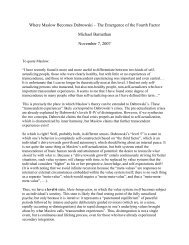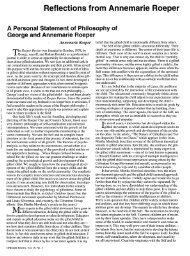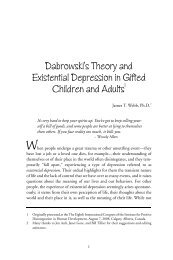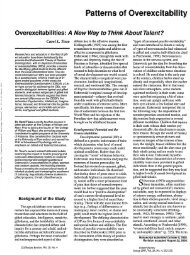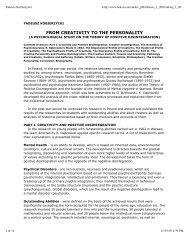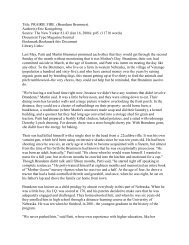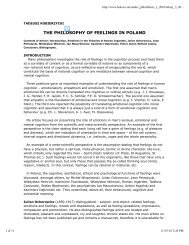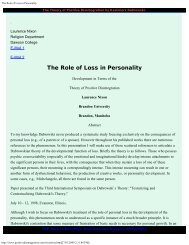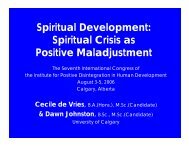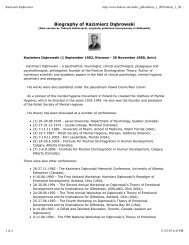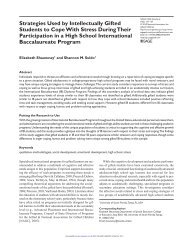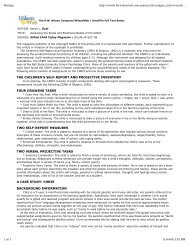Selective Serotonin Enhancers and the Theory of Positive ...
Selective Serotonin Enhancers and the Theory of Positive ...
Selective Serotonin Enhancers and the Theory of Positive ...
- No tags were found...
Create successful ePaper yourself
Turn your PDF publications into a flip-book with our unique Google optimized e-Paper software.
nec tecum possum vivere, nec sine teMartialI can’t live with you – nor without youv
<strong>Selective</strong> <strong>Serotonin</strong> <strong>Enhancers</strong> <strong>and</strong> <strong>the</strong> <strong>Theory</strong> <strong>of</strong> <strong>Positive</strong> DisintegrationBack to Prozac (Breggin <strong>and</strong> Breggin, 1994). Breggin, a vocal critic <strong>of</strong> psychotropic treatment, assails<strong>the</strong> development, promotion <strong>and</strong> use <strong>of</strong> Prozac (Breggin, 1991; Breggin & Breggin, 1994).The discussions on Prozac have contributed to <strong>the</strong> impression that Medicine will soon reach <strong>the</strong> point<strong>of</strong> enabling people to change <strong>the</strong>ir personalities <strong>and</strong> moods at will. Millard (1994) wrote that Krammer"conjures up <strong>the</strong> image <strong>of</strong> a society where valued personal qualities can be chemically engineered" (p.18). Richard Restak (1993, p. 9) believes that "<strong>the</strong> new drugs that change <strong>the</strong> chemistry <strong>of</strong> <strong>the</strong> brainmake clear that we can change our internal states deliberately" <strong>and</strong> that we are on <strong>the</strong> verge <strong>of</strong>"chemical attempts to modify character" (quoted in Begley, 1994, p. 37). These general impressionsare promoted on <strong>the</strong> newsst<strong>and</strong>, for example, by <strong>the</strong> 1994 Newsweek cover headline, "BeyondProzac: How science will let you change your personality with a pill."In summary, <strong>the</strong> use <strong>and</strong> expectations <strong>of</strong> Prozac appear to have no bounds. It has been a rapid <strong>and</strong>effective agent in changing how people feel. The widespread use <strong>of</strong> SSRI medications affectspeople's phenomenological experience <strong>of</strong> depression <strong>and</strong> crises, <strong>and</strong> <strong>the</strong> way <strong>the</strong>y will cope <strong>and</strong> reactpsychologically. Ultimately, it may affect <strong>the</strong>ir motivation to deal with <strong>the</strong>ir deeper problems. The fullimpact <strong>of</strong> this, both on <strong>the</strong> individual <strong>and</strong> for our <strong>the</strong>rapeutic approaches, remains to be seen.The <strong>Theory</strong> <strong>of</strong> <strong>Positive</strong> DisintegrationThe <strong>Theory</strong> <strong>of</strong> <strong>Positive</strong> Disintegration (TPD), developed by K. Dabrowski, is a complex <strong>and</strong>comprehensive <strong>the</strong>ory <strong>of</strong> personality development (Dabrowski, 1937, 1964, 1966, 1967, 1977;Dabrowski, Kawczak, & Piechowski, 1970, Dabrowski, 1972; Dabrowski, Kawczak, & Sochanska,1973; Dabrowski & Piechowski, 1977). As indicated in <strong>the</strong> introduction, <strong>the</strong> <strong>the</strong>ory postulates thatsuffering, crisis <strong>and</strong> disintegration play vital roles in easing personality development. Dabrowski (1967,p. 76-77) said "we are speaking <strong>of</strong> a positive disintegration when it transforms itself gradually or, insome cases, violently into a secondary integration.' A second possibility is a chronic, lifelong state <strong>of</strong>disintegration. This would be termed a positive disintegration if it "enriches one's life, exp<strong>and</strong>s one'shorizons, <strong>and</strong> produces sources <strong>of</strong> creativity (Dabrowski, 1967, p. 77). Dabrowski used <strong>the</strong> termdisease in a literal sense <strong>and</strong> believed that <strong>the</strong> disruption <strong>of</strong> ease was <strong>of</strong>ten a motivation towardgrowth. How could personality growth or change be accomplished without sufficient motivation - thatis, without dis-ease? How can one's personality change without a reordering <strong>of</strong> its initial properties <strong>and</strong>how is this to come about without first having a painful disordering <strong>of</strong> some sort occur?Developmental Potential <strong>and</strong> OverexcitabilityDabrowski observed that not everyone appears to have <strong>the</strong> same potential for personalitydevelopment. He believed that developmental potential is set by <strong>the</strong> resultant product <strong>of</strong> a person'sgenetic potentials <strong>and</strong> <strong>of</strong> subsequent environmental-genetic interactions. Our specific interest here isin disintegration, <strong>the</strong> basic mechanism <strong>of</strong> development. Dabrowski postulated that developmentalpotential consists <strong>of</strong> several features that encourage <strong>and</strong> facilitate a continuum <strong>of</strong> disintegrativeprocesses. Brief, partial disintegrations may be followed by reintegrations on <strong>the</strong> same level (nohttp://www.positivedisintegration.com/ssri.htm[27/01/2009 2:33:03 PM]
<strong>Selective</strong> <strong>Serotonin</strong> <strong>Enhancers</strong> <strong>and</strong> <strong>the</strong> <strong>Theory</strong> <strong>of</strong> <strong>Positive</strong> Disintegrationreplaced by "what ought to be"; a "new" view, reflecting <strong>the</strong> unique personality <strong>and</strong> value hierarchy <strong>of</strong><strong>the</strong> unfolding, autonomous individual. As <strong>the</strong>se internal values become more prominent, <strong>the</strong>yincreasingly influence a person's perceptions <strong>and</strong> behaviour. Accordingly, behaviour comes to beguided by <strong>the</strong> individual choices <strong>of</strong> <strong>the</strong> person. The presence <strong>of</strong> strong empathy, implicit in deepemotional experience, ensures that <strong>the</strong> developing personality will be founded upon sincere <strong>and</strong>au<strong>the</strong>ntic human values.Developmental Factors <strong>and</strong> <strong>the</strong> Continuum <strong>of</strong> DistressFour factors seem particularly important in our discussion <strong>of</strong> development. The first three are fromDabrowski's <strong>the</strong>ory, <strong>the</strong> genetic potentials for development, environmental experience <strong>and</strong> <strong>the</strong>strength <strong>of</strong> autonomous developmental dynamisms. The fourth factor I am adding is an individual's"optimal distress level." Too little conflict <strong>and</strong> one will fall short <strong>of</strong> <strong>the</strong> threshold needed to produce <strong>the</strong>motivation to change ("dis-ease"), however, too much distress may also impair one's ability todevelop. At <strong>the</strong> height <strong>of</strong> a crisis, where does an individual fall on <strong>the</strong> continuum <strong>of</strong> distress?Dabrowski was very aware <strong>of</strong> <strong>the</strong> psychological dem<strong>and</strong>s <strong>of</strong> disintegration <strong>and</strong> emphasized <strong>the</strong>discontinuous nature <strong>of</strong> development. When challenged to excess, <strong>the</strong> psyche could breakdown,resulting in negative disintegration, psychosis or suicide (Dabrowski, 1967). Therefore, <strong>the</strong> use <strong>of</strong>medication might be a necessary option in some cases. The person has to survive <strong>the</strong>ir disintegration.Medication may be required to reduce distress <strong>and</strong> anxiety to prevent an individual from being totallyoverwhelmed. This balance is a difficult one because <strong>the</strong> person may seek relief from <strong>the</strong> intensity <strong>of</strong><strong>the</strong>ir crisis. In many cases, Dabrowski encouraged people to view <strong>the</strong>ir crisis from a developmentalperspective <strong>and</strong> to endure <strong>and</strong> learn from <strong>the</strong>ir distress. In many cases, <strong>the</strong> pain <strong>of</strong> life needs to be felt<strong>and</strong> <strong>the</strong> role <strong>of</strong> <strong>the</strong> <strong>the</strong>rapist is reduced to "doing nothing when <strong>the</strong>re is nothing to be done."The Developmental RespiteAs noted above, Dabrowski saw that most people display discontinuous development. It is common tosee many advances <strong>and</strong> retreats over time. When <strong>the</strong> psyche is in danger <strong>of</strong> being overwhelmed, itmight retreat from disintegration. This could take <strong>the</strong> form <strong>of</strong> a positive regression throughreintegration at <strong>the</strong> former level <strong>of</strong> functioning or by a partial reintegration on a slightly higher level.Dabrowski called this type <strong>of</strong> sequence a partial disintegration. When <strong>the</strong> pressures <strong>of</strong> disintegrationappear overwhelming, <strong>the</strong> judicious use <strong>of</strong> a medication, such as an SSRI, could be considered toallow for a respite in <strong>the</strong> developmental process.Working with medication to establish <strong>the</strong> optimal level <strong>of</strong> distress or in managing developmentalrespites would be particularly important (but most challenging) in <strong>the</strong> creative individual where <strong>the</strong> linebetween creativity <strong>and</strong> pathology may be blurred.Links to CreativityThe experiences <strong>of</strong> "creative" individuals may best exemplify our present concerns. Psychiatry haslong struggled with creativity <strong>and</strong> <strong>the</strong> "madness <strong>of</strong> genius" (see eg. Prentky, 1980; Andreasen, 1987;http://www.positivedisintegration.com/ssri.htm[27/01/2009 2:33:03 PM]
<strong>Selective</strong> <strong>Serotonin</strong> <strong>Enhancers</strong> <strong>and</strong> <strong>the</strong> <strong>Theory</strong> <strong>of</strong> <strong>Positive</strong> DisintegrationPost, 1994; Yewchuk, 1995). Various figures in artistic <strong>and</strong> creative fields have met with sad ends at<strong>the</strong> h<strong>and</strong>s <strong>of</strong> psychiatric intervention. Francis Farmer, Antonin Artaud, E. Hemingway <strong>and</strong> W. Reichreadily come to mind. Anthony Storr even suggested that Einstein's insights could have been a byproduct<strong>of</strong> schizophrenia (White & Gribbin, 1993).The need to suffer to facilitate creativity is also part <strong>of</strong> <strong>the</strong> artistic tradition ("to suffer for <strong>the</strong> sake <strong>of</strong>one's art"). For example, <strong>the</strong> high incidence <strong>of</strong> suicide <strong>and</strong> alcoholism is almost considered anoccupational hazard among authors. As poet John Berrymore, who committed suicide, noted, "<strong>the</strong>artist is extremely lucky who is presented with <strong>the</strong> worst possible ordeal which will not actually kill him"(Morris, 1991, p. 195).Jamison (1995) has clearly articulated <strong>the</strong> need for balance <strong>and</strong> underst<strong>and</strong>ing in <strong>the</strong> psychiatricintervention <strong>of</strong> persons with developmental <strong>and</strong> creative strengths. She states "useful interventionmust control <strong>the</strong> extremes <strong>of</strong> depression <strong>and</strong> psychosis without sacrificing crucial human emotions<strong>and</strong> experiences" (Jamison, 1995, p. 67). The forces <strong>and</strong> consequent experiences that contribute topersonality development overlap with <strong>the</strong> forces that shape <strong>the</strong> creative experience. This suggeststhat creative people, as a group, will be prone to acute psychological distress, a finding borne out in<strong>the</strong> literature (e.g., Andreasen, 1987; Arieti, 1980; Post, 1994; Prentky, 1980). Individuals who exhibitmore potential for growth <strong>and</strong> creativity will also be more vulnerable to breakdown. The key question,as Jamison has articulated, is to balance support <strong>and</strong> intervention when required without dulling <strong>the</strong>creative experience.ConclusionThis paper has outlined <strong>the</strong> popularity <strong>and</strong> role <strong>of</strong> SSRI medications <strong>and</strong> has raised questionsconcerning <strong>the</strong> effect that rapid <strong>and</strong> effective pharmaceutical intervention will have on <strong>the</strong>psychological experience <strong>and</strong> motivation <strong>of</strong> those under treatment. This concern is especially relevantfor philosophies <strong>and</strong> <strong>the</strong>rapies that emphasize <strong>the</strong> potential positive aspects <strong>of</strong> human suffering. TheTPD is discussed as an example <strong>of</strong> a <strong>the</strong>ory that views conflict <strong>and</strong> disintegration as a vital part <strong>of</strong> <strong>the</strong>human growth experience. It is suggested that a model <strong>of</strong> development <strong>and</strong> intervention shouldconsider genetic <strong>and</strong> environmental potentialities in relation to an individual's "optimal" distress level.I hope that <strong>the</strong> concerns raised in this paper will add ano<strong>the</strong>r important consideration in <strong>the</strong> judicioususe <strong>of</strong> medications. Intervention must not sacrifice a person's opportunity to be fully human <strong>and</strong> mustbalance <strong>the</strong> risks presented by <strong>the</strong> breakdown (eg. suicide) versus <strong>the</strong> potentials for insight, growth<strong>and</strong> creativity. Ideally, intervention would take a supportive but passive role - being with a personthrough a breakdown that challenges but does not overwhelm, <strong>and</strong> that eventually leads to <strong>the</strong>achievement <strong>of</strong> new <strong>and</strong> significant insights.ReferencesAndreasen, N. C. (1987). Creativity <strong>and</strong> mental illness: Prevalence rates in writers <strong>and</strong> <strong>the</strong>ir firstdegreerelatives. American Journal <strong>of</strong> Psychiatry, 144(10), 1288-1292.http://www.positivedisintegration.com/ssri.htm[27/01/2009 2:33:03 PM]
<strong>Selective</strong> <strong>Serotonin</strong> <strong>Enhancers</strong> <strong>and</strong> <strong>the</strong> <strong>Theory</strong> <strong>of</strong> <strong>Positive</strong> DisintegrationArieti, S. (1980). Man's spirituality <strong>and</strong> potential for creativity as revealed in mental illness.Comprehensive Psychiatry, 21(6), 436-443.Baldessarini, R. J. (1986). A summary <strong>of</strong> biomedical aspects <strong>of</strong> mood disorders. In J. C. Coyne (Ed.),Essential papers on depression (pp. 459-492). New York: New York University Press.Barondes, S. (1994, February 25). Thinking about Prozac. Science, 263, 1102-1103.Begley, S. (1994, February 7). One pill makes you larger, <strong>and</strong> one pill makes you small ... Newsweek,CXXIII, 37-40.Breggin, P. (1991). Toxic Psychiatry: Why <strong>the</strong>rapy, empathy <strong>and</strong> love must replace <strong>the</strong> drugs,electroshock, <strong>and</strong> biochemical <strong>the</strong>ories <strong>of</strong> <strong>the</strong> "new psychiatry". New York: St. Martin's Press.Breggin, P., & Breggin G. (1994). Talking back to prozac: What doctors aren't telling you about today'smost controversial drug. New York: St. Martin's Press.Coccaro, E. (1989). Central serotonin <strong>and</strong> impulsive aggression. British Journal <strong>of</strong> Psychiatry, 155,52-56.Cooper, J. R., Bloom, F. E. & Roth, R. H. (1986). The biochemical basis <strong>of</strong> neuropharmacology (5<strong>the</strong>d.). New York: Oxford University Press.Costello, C. G. (1976). Anxiety <strong>and</strong> depression: The adaptive emotions. Montreal: McGill-Queen'sUniversity Press.Cowley, G. (1994, February 7). The culture <strong>of</strong> prozac. Newsweek, CXXIII, 41-42.Dabrowski, K. (1937). Psychological basis <strong>of</strong> self-mutilation. Genetic Psychology Monographs, 19, 1-104.Dabrowski, K. (1964). <strong>Positive</strong> Disintegration. Boston: Little Brown.Dabrowski, K. (1966). The <strong>Theory</strong> <strong>of</strong> <strong>Positive</strong> Disintegration. International Journal <strong>of</strong> Psychiatry, 2,229-244.Dabrowski, K. (1967). Personality-Shaping Through <strong>Positive</strong> Disintegration. Boston: Little Brown.Dabrowski, K., with Kawczak, A., & Piechowski, M. M. (1970). Mental Growth Through <strong>Positive</strong>Disintegration. London: Gryf.Dabrowski, K. (1972). Psychoneurosis Is Not An Illness. London: Gryf.Dabrowski, K. (1973). Developmental Psycho<strong>the</strong>rapy: Psycho<strong>the</strong>rapy Based on <strong>the</strong> <strong>Theory</strong> <strong>of</strong> <strong>Positive</strong>Disintegration. Unpublished manuscript.http://www.positivedisintegration.com/ssri.htm[27/01/2009 2:33:03 PM]
<strong>Selective</strong> <strong>Serotonin</strong> <strong>Enhancers</strong> <strong>and</strong> <strong>the</strong> <strong>Theory</strong> <strong>of</strong> <strong>Positive</strong> DisintegrationDabrowski, K. with Piechowski, M. M. (1977). <strong>Theory</strong> <strong>of</strong> Levels <strong>of</strong> Emotional Development: Volume 1 -Multilevelness And <strong>Positive</strong> Disintegration. Oceanside, New York: Dabor.Dabrowski, K. & Piechowski, M. M. (1977). <strong>Theory</strong> <strong>of</strong> Levels <strong>of</strong> Emotional Development: Volume 2 -From Primary Integration To Self-Actualization. Oceanside, New York: Dabor.Feighner, J. P., & Boyer, W. F. (Eds.) (1991). <strong>Selective</strong> serotonin re-uptake inhibitors. New York: JohnWiley & Sons.Fieve, R. (1994). Prozac: Questions <strong>and</strong> answers for patients, family <strong>and</strong> physicians. New York: AvonBooks.Frankl, V. (1963). Man's search for meaning: An introduction to logo<strong>the</strong>rapy. New York: WashingtonSquare.Gendlin, E. T. (1962). Experiencing <strong>and</strong> <strong>the</strong> Creation <strong>of</strong> Meaning. New York: Free Press.Jacobs, B. (1994, September-October). <strong>Serotonin</strong>, motor activity <strong>and</strong> depression-related disorders.American Scientist, 82, 456-463.James, W. (1889/1900). On Some <strong>of</strong> Life's Ideals. New York: Henry Holt.Jamison, K. R. (1995, February). Manic-Depressive illness <strong>and</strong> creativity. Scientific American, 272,62-67.Kaplan, H. I. & Sadock, B. J. (1991). Synopsis <strong>of</strong> psychiatry: Behavioral sciences, clinical psychiatry(6th ed.). Baltimore: Williams & Wilkins.Kauffman, G. B. (1995). Review <strong>of</strong> <strong>the</strong> book Listening to prozac: A psychiatrist exploresantidepressant drugs <strong>and</strong> <strong>the</strong> remaking <strong>of</strong> <strong>the</strong> self. [Book]. American Scientist, 83(1), 90-91.Krammer, P. (1993). Listening to prozac: A psychiatrist explores antidepressant drugs <strong>and</strong> <strong>the</strong>remaking <strong>of</strong> <strong>the</strong> self. New York: Penguin Books.Krogh, C. M. (Ed.). (1995). Compendium <strong>of</strong> pharmaceuticals <strong>and</strong> specialities. Ottawa Ontario:Canadian Pharmaceutical Association.Millard, W. (1994, November 15). Inside p<strong>and</strong>ora's box. Patient Care, 16-24.Morris, D. B. (1991). The culture <strong>of</strong> pain. Berkeley: University <strong>of</strong> California Press.Post, F. (1994). Creativity <strong>and</strong> psychopathology. British Journal <strong>of</strong> Psychiatry, 165, 22-34.Prentky, R. A. (1980). Creativity <strong>and</strong> psychopathology: A neurocognitive perspective. New York:Praeger.http://www.positivedisintegration.com/ssri.htm[27/01/2009 2:33:03 PM]
<strong>Selective</strong> <strong>Serotonin</strong> <strong>Enhancers</strong> <strong>and</strong> <strong>the</strong> <strong>Theory</strong> <strong>of</strong> <strong>Positive</strong> DisintegrationRaine, A. (1993). The psychopathology <strong>of</strong> crime: Criminal behavior as a criminal disorder. San Diego:Academic Press.Restak, R. (1993) Receptors. New York: Bantam Books.Rubens, R. L. (1992). Psychoanalysis <strong>and</strong> <strong>the</strong> Tragic Sense <strong>of</strong> Life. New Ideas in Psychol., 10(3),347-362.Teicher, M., Glod, C., & Cole, J. (1990). Emergence <strong>of</strong> intense suicidal preoccupation duringfluoxetine treatment. American Journal <strong>of</strong> Psychiatry, 147, 207-210.Unamuno, M. de (1972). The Tragic Sense <strong>of</strong> Life in Men <strong>and</strong> Nations. Princeton: Princeton UniversityPress.Virkunnen, M., DeJong, J., & Bartko, J. (1989). Relationship <strong>of</strong> psychobiological variables torecidivism in violent <strong>of</strong>fenders <strong>and</strong> impulsive firesetters. Archives <strong>of</strong> General Psychiatry, 46, 600-603.White, M. & Gribbin, J. (1993). Einstein: A life in science. London: Simon & Schuster.Wright, R. (1995, March 13). The biology <strong>of</strong> violence. The New Yorker, 68-77.Yewchuk C. R. (1995). The "mad genius" controversy: Implications for gifted education. Journal for <strong>the</strong>Education <strong>of</strong> <strong>the</strong> Gifted, 19(1), 3-29..http://www.positivedisintegration.com/ssri.htm[27/01/2009 2:33:03 PM]



